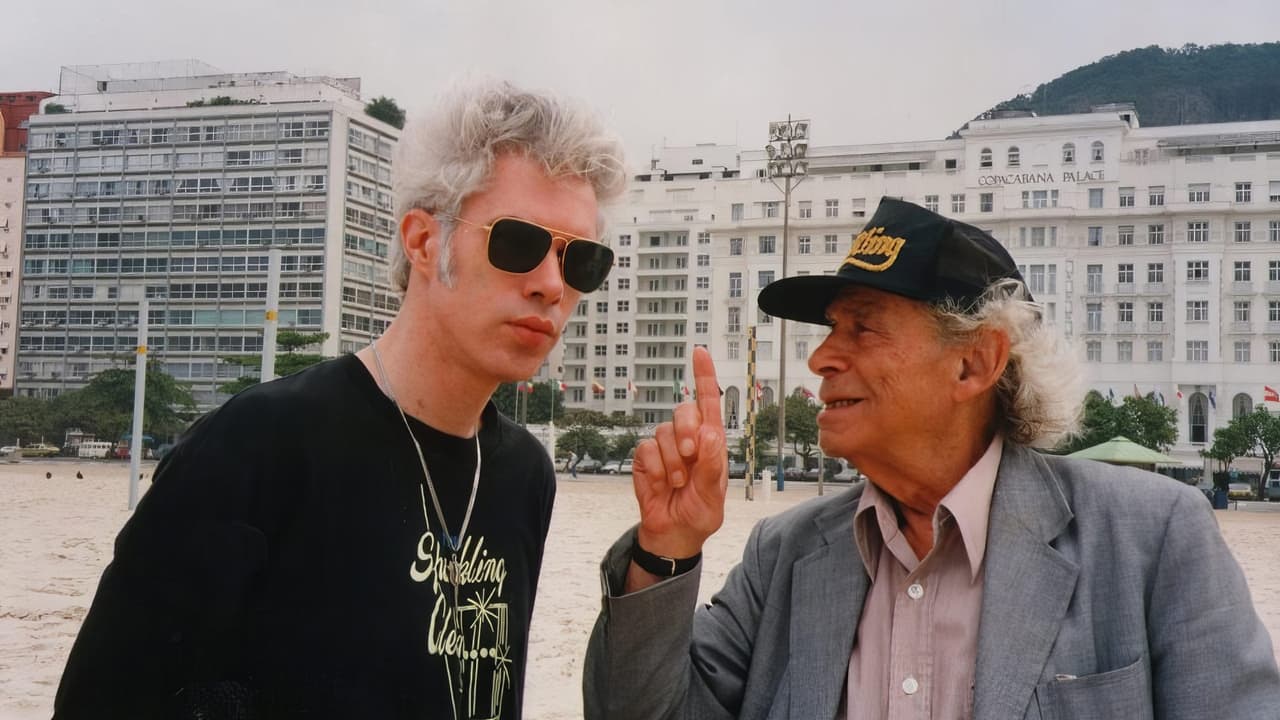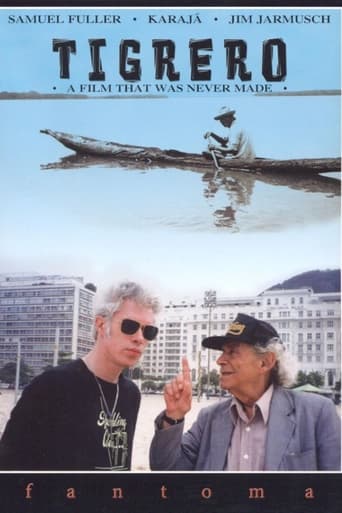



Wonderful character development!
Blending excellent reporting and strong storytelling, this is a disturbing film truly stranger than fiction
View MoreExcellent and certainly provocative... If nothing else, the film is a real conversation starter.
View MoreThe film's masterful storytelling did its job. The message was clear. No need to overdo.
View MoreThe image of hipster Jarmusch and Old-School Fuller wandering around like 2 characters in search of an epiphany was wacky enough. Place them in the middle of a Karaja village, with the amazing back-story of Fuller's flirtation with a jungle epic-that-never-was, and you've got a great little documentary that surpasses expectations--if in fact you had any. It's true that Jarmusch is absurdly out of place here, but that only ads to the surrealistic bent of the thing. And Fuller, a physical midget next to Jarmusch, is the one who is truly larger than life; a throwback to a time when directors truly dreamed and took action--the sort of character that Hollywood, in its increasing dependence on CGI, has conveniently squelched. We get to see a maverick, a dreamer, an egotist and a great observer of life in its myriad forms, who clearly loved every second of his time on this earth. The film is somewhat hampered by a lack of what a script man would call structure. And yet that didn't bother me because it was like watching a human circus unfolding: Here a Karaja ritual; there, Fuller fulminating about what coulda been, and everywhere around the amazing Mato Grosso, the real star of the story. Okay, it's no Aguirre, but if you love the process of film in its purest form, this is a terrific little flick.
View MoreIt is true that offbeat documentary film "Tigrero: A Film That Was Never Made" has its own intrinsic star value featuring maverick American independent cinema artists Samuel Fuller and Jim Jarmusch but the real stars of this charming film within a film tale are "The Karaja",native people from Brazil.In many ways this documentary by Finnish cinema author Mika Kaurismaki is an amazing journey into heart, minds and souls of Karaja people who teach viewers a humble lesson of humanity.We get to learn that even though they are close to human civilization,it is normal for them to maintain their distance from modern people.This is a unique quality which has found many admirers especially people like Samuel Fuller and Jim Jarmusch who make good friends with Karaja people."Tigrero: A Film That Was Never Made" is also a film with serious purpose as its protagonists arrive in style to explore new facets in film making.Each of them have their own agendas: Jim Jarmusch with his ubiquitous video camera and Samuel Fuller with his charming cigar.As Mika Kaurismaki has made a film oozing with emotional attachment related to true love for cinema,one has to really feel the sadness with which Samuel Fuller narrates how his unfinished film "Tigrero" with big names of Hollywood cinema John Wayne,Ava Gardner and Tyrone Power could not be made due to malicious attitude of American insurance companies.One has to pay attention to each word uttered by Samuel Fuller,a legendary director whose genius could not be appreciated by many in Hollywood.It is true that Samuel Fuller's widow Christa Lang gave the idea for making "Tigrero: A Film That Was Never Made" but Mika Kaurosmakin must be congratulated for making a great film as his approach is humanist in nature as his film is an honest vision of a genius who should have been properly recognized by Hollywood and American film industry.
View MoreI didn't find Tigrero: A Film That Was Never Made to be one that worked completely as a documentary, but there was a lot that I did admire about it. The director Mika Kaurismaki (of the Kaurismaki brothers, the famous Finnish filmmakers) chooses to not just plunge the viewer into the Karaja culture, of which Tigrero is mostly set in, but sets up a sort of 'huh' opening scene where director Samuel Fuller persuades Jim Jarmisch to go with him on a trip into the jungles of Brazil for some odd reason or another. I could get a sense of what Kaurismaki was after with this, to make the documentary feel more like a hybrid, like something out of Jarmusch's own Coffe & Cigarettes where the real people are themselves, only still playing characters. But the film really only gets some lift once Kaurismaki gives up on the scripted stuff- which isn't awful but feels like it's out of some other movie- and gets to the facts, the images of total reality and the stories of old. In this case, like with Les Blank's Burden of Dreams, Kaurismaki is almost more interested in the native people of the area, the Karaja, who were there for centuries when Fuller arrived in 1956 to do some 16mm rough shooting of the area for a film he was preparing (of the title here).In fact, I wondered after a while when Kaurismaki would get to the story behind the 'film never made', as he continually shows the Karaja and their customs. This isn't a bad thing at all actually, and there are even a couple of wonderfully strange moments, like the two men doing their chant as their stuck together and go by the cigar-chomping Fuller. Or when we see how the natives do their mating ritual, which involves the men being covered completely by bushes and going around the women, who rub their bellies in hope of having babies. But really, part of the touching factor is just in seeing how these people lived and payed heed to nature, which is their sort of God, however not exactly their God as Fuller observes "they don't know what God is" (he makes a note, however, that Christians don't either, but they just flaunt it more). With all of this footage, either shot by Kaurismaki or Fuller or even through Jarmusch as he carries around a camcorder, it's all very absorbing on an anthropological level, and the history behind the people too is interesting, how the Westerners came into try and modernize, and they almost crushed their culture.Once this is mostly through with we do finally get to Fuller talking about Tigrero, and it's pretty much worth the wait to hear one of the giants of American film in the 50s and 60s (both studio-wise and independent) talk about the ambition of it all, how John Wayne and Ava Gardner would be cast, how it all rung of slight subversion of the action/adventure picture set in exotic locations. It's always a treat too just to hear how Fuller tells these stories, no b.s. involved ever, and how after the crushing blow from the insurance company that the film could not go on (they wouldn't want to put up the millions of dollars in case, well, one of the stars died), how he integrated the footage into Shock Corridor. Jarmusch also makes sure the questions are direct as possible, however with a good level of adoration from an obvious fan, and with his own dead-pan narration telling of the Karaja's stories and the like. By the end, I knew I had seen at least 2/3 of an excellent documentary on a group of people I'd never known before, and had seen things about their ways of life and understanding of one another that was fulfilling, and from knowing another lot of great lost stories by a filmmaker who knew his stuff. If only Kaurismaki wouldn't get in the way sometimes.
View MoreI somewhat agree with the comments about the scripted components, but I don't think they really do any damage to the film.This docco has a lot of range, its tear jerkingly poignant in places, downright hilarious in others, and just astounding in others. The chief witchdoctors doing their elaborate ritual, fainly chanting 'Hollywood... Hollywood...' is a really transporting moment.The film definitely causes one to wonder about the future of the natives, whether they will go on as they have in their idyllic little universe.Strange thing is - I'm not actually that much of a Jim Jarmusch fan (yes I know he didn't direct this film but he would have had a lot of input), except for Dead Man which is a masterpiece. But this is a little gem.I recommend this film, its cute and beautiful.
View More